LESSON 5. Managing and Updating Your Profile
In this lesson, you learn how to update your LinkedIn status and profile, promote your profile on the web, and print and download your profile.
Understanding the Importance of a Current Profile
Keeping your profile current is critical to your success on LinkedIn. Creating your initial profile might be a one-time task, but you need to update it regularly to let others know you’re an active participant on LinkedIn. In addition to updating your actual profile, LinkedIn enables you to post frequent updates to inform your network about your activities and accomplishments.
Understanding LinkedIn Updates
LinkedIn enables you to share important news with other LinkedIn members in text updates of up to 600 characters. You can also insert URLs in your updates with a title, description, and optional photo. For example, you could link to your website, a blog post, or an article on an external news site. If you want to share your LinkedIn updates on Twitter, you should limit them to 140 characters. Otherwise, only the first 140 characters of your update will display on Twitter. Refer to Lesson 2, “Creating Your Profile,” for more information about integrating LinkedIn with Twitter.
Figure 5.1 shows an example of a brief text-only update that’s suitable for cross-posting on Twitter.
Figure 5.1. Quickly let your connections know what’s new in your professional life.

Figure 5.2 shows an example of an update that includes a link to a blog posting.
Figure 5.2. Showcase relevant blog posts with a LinkedIn update.
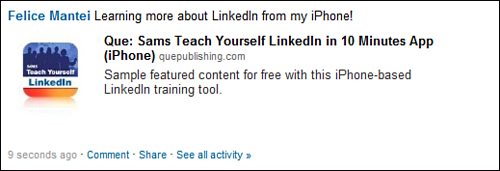
When you post an update, it displays in several places:
• At the top of your profile just below your name and headline
• In the Activity section of your profile, located in the right column
• In the Network Activity section of your home page
• In the Network Activity section of your connections’ home page—if you choose to share with them
Your update remains indefinitely until you either delete it or replace it with a new update.
Although updates are a fun way to let your connections know what’s new in your life, they are also a strategic networking tool. Keep your goals in mind and post updates that help achieve them. A well-crafted update can be an effective marketing and publicity tool, but be careful to avoid overt sales pitches in your updates. An update is a conversation with your network, not an advertisement.
Posting an Update
To post an update on LinkedIn, follow these steps:
- On the global navigation bar, select Edit Profile from the Profile drop-down menu.
- On the Edit Profile tab, click the Post an Update link.
- Enter your update in the box that appears, as shown in Figure 5.3. Remember that you can enter up to 600 characters unless you want to share your update on Twitter. In that case, you should limit your update to 140 characters (Twitter cuts off anything in excess of this length).
Figure 5.3. Post an update to let other LinkedIn members know what you’re doing.
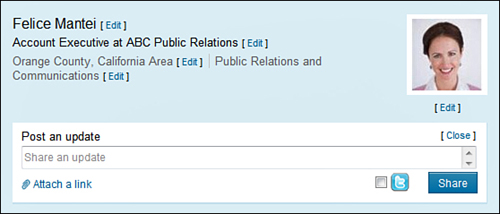
- If you want to refer to an external URL, click the Attach a Link link. If not, skip to step 10.
- Enter the URL you want to include in the Add URL box, such as http://www.quepublishing.com.
- Click the Attach button. LinkedIn searches for this URL and displays a title, description, and photo from the content it finds on this page (see Figure 5.4).
Figure 5.4. Attach links to relevant external sites, such as a website, blog, or news site.
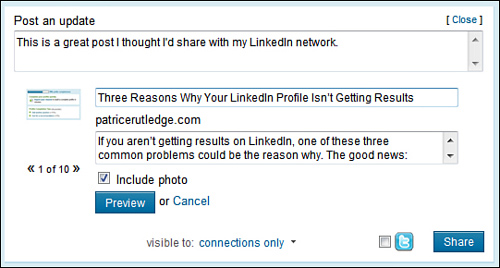
- Optionally, click the Edit link to make changes to this default content.
- Enter any changes to the title or description in the text boxes. Remember that the description text displays in addition to what you enter in the update box.
- The Include Photo check box is selected by default, but you can remove this check mark if you don’t want to include a photo. To change from the default photo, click the arrows below the photo to view alternative selections. LinkedIn searches for any photos on the page you’re sharing and offers them as options.
- Click the down arrow to the right of the Visible To drop-down list to specify who can see this update. You can share with everyone on LinkedIn or only with your connections.
- If you set up LinkedIn to integrate with Twitter, you can select the check box to the left of the Twitter button to share your update on Twitter. If you haven’t set up LinkedIn–Twitter integration yet, you’re prompted to do so before continuing. Refer to Lesson 2 for more information about setting up this integration.
- Click the Share button to post your update, as shown in Figure 5.5.
Figure 5.5. An update as it displays on your profile.

LinkedIn displays this update on your profile and home page. Your connections can also view this update on your profile and the Network Activity section of their home pages. If you choose to share with everyone, any LinkedIn member who visits your home page can view your updates, but your updates won’t appear on their home pages unless you connect with them.
Managing Your Updates
After posting an update, you can
• Delete the update by clicking the Delete Your Update button (a large X) in the upper-right corner of your update box or in the [First Name’s] Activity section in the right column.
• Share your update with groups you belong to or individual connections by clicking the Share link below your update. Figure 5.6 shows the Share dialog box, which opens.
Figure 5.6. Share your update with group members and individual connections.
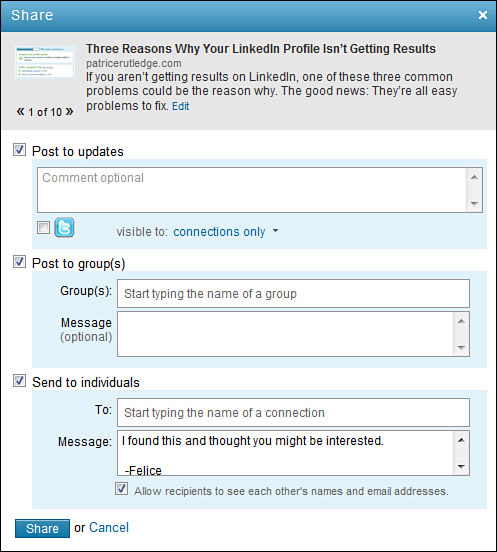
• View a list of your latest updates by clicking the See All Activity link below your update.
Commenting on an Update
When your update appears in your connections’ Network Activity section on their home pages, they can
• Enter their own comments by clicking the Comment link below your update. If your connections have entered comments about your update, you’ll see a link beneath your posted update on your home page and on your profile. The link tells you how many comments you have (for example, 2 Comments). Click this link to view your comments and add your own feedback to the discussion.
• Send you a private message by clicking the Send a Message link.
• Show their support for your update by clicking the Like link.
• Share your update with their connections or fellow group members or in an update of their own.
Tip: Add Comments to Participate in the LinkedIn Community
Adding your own comments to your connections’ updates is a good way to stay in touch and maintain visibility.
Updating Your Profile
Even if you create a thorough profile when you first sign up for LinkedIn, you’ll eventually want to update it with recent information.
You should update your LinkedIn profile whenever your employment status changes, you receive a degree or certification, win an award, learn a new skill, start a new business, achieve a career milestone, or change your LinkedIn goals. To update your profile, select Edit Profile from the Profile drop-down menu on the global navigation bar. The Profile page opens with the Edit Profile tab active, as shown in Figure 5.7.
Figure 5.7. Be sure to update your profile regularly with new information.
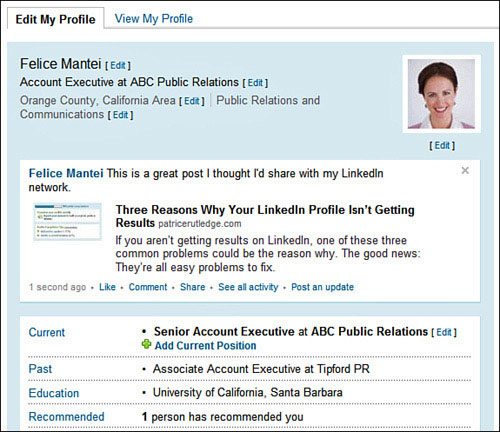
The Edit Profile tab is the same place you first created your profile, so you should already be familiar with its content. After you first enter profile data, links such as Add a Past Position or Add a School disappear. Instead, click the Edit link next to any field you want to update. The appropriate LinkedIn page opens, where you can make any required changes.
Refer to Lesson 2 for more information about the content you can enter on the Edit Profile tab.
Caution: Don’t Let Your Profile Get Outdated
Although it’s not necessary to update your profile every week, you shouldn’t let it get outdated either. If it’s obvious that you haven’t touched your profile in months, or years, LinkedIn members might not bother contacting you for what could have been a lucrative opportunity for you.
Promoting Your Profile on the Web
With your permission, LinkedIn makes a public version of your profile available for view and search on the web. Figure 5.8 shows a sample LinkedIn profile link in Google search results.
Figure 5.8. Your LinkedIn public profile appears in Google search results.

Tip: Promote Your LinkedIn Profile in Print
Although promoting your profile online is most common, many LinkedIn members also print their LinkedIn profile URL on business cards, brochures, and other marketing materials.
To customize the appearance of your public profile, go to the global navigation bar, click the down arrow to the left of your name, and select Settings from the drop-down menu. On the Account & Settings page, click the Public Profile link.
Lesson 2 provided details on how to manage your public profile. As a reminder, here are tips to maximize your profile’s online visibility:
• Customize your public profile URL to make it user-friendly, such as http://www.linkedin.com/in/patriceannerutledge.
• Select the Full View option on the Public Profile page and place a check mark next to all fields you want to appear on your public profile.
• Preview your public profile to ensure that you like how it appears to others on the web.
In addition to maintaining a public profile, you can also post a LinkedIn button on your website, blog, or online resume. Figure 5.9 shows a sample button.
Figure 5.9. Add a LinkedIn button to your website so that site visitors can view your profile.
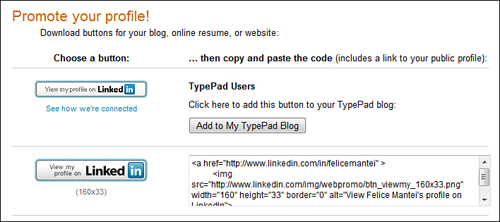
Click the Customized Buttons link on the Public Profile page to open the Promote Your Profile! page, where you can select the button style you prefer. LinkedIn offers a special button for TypePad users, but you can place your button on any blog or website. For example, a blog sidebar is a great place for a LinkedIn button. Copy the HTML code LinkedIn provides and paste it into your own site.
Another way to promote your LinkedIn profile on the web is to include a link to your public profile URL in your email signature, on your online business card, or on other social sites such as Facebook or Twitter.
Tip: Promote Your LinkedIn Profile on Facebook
If you use Facebook (www.facebook.com), consider installing the My LinkedIn Profile application on your Facebook profile.
Printing and Downloading Your Profile
You can print and download your profile, or the profile of another LinkedIn member, by clicking one of the icons in the upper-right corner of a profile, shown in Figure 5.10.
Figure 5.10. Print or download your profile using one of the icons.
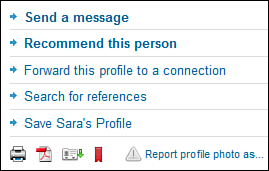
• Print This Profile: Opens the Print dialog box in which you can specify print options and print a profile.
• Download as PDF: Creates a PDF document from your profile that you can view with Adobe Reader (get.adobe.com/reader).
• Download vCard: Downloads your profile in the vCard format, which is a file format used for electronic business cards. This option appears only for your own profile or for your connections.
Summary
In this lesson, you learned how to update your status and profile, promote your profile on the web, and print and download your profile. Next, learn the many ways to communicate with other members and become part of the LinkedIn community.
